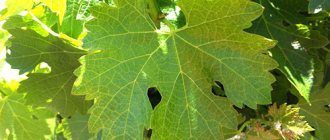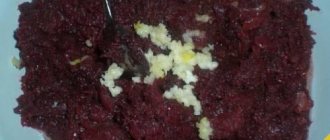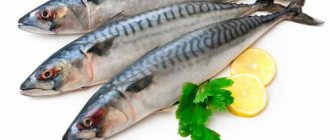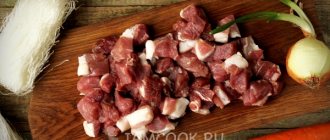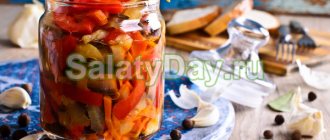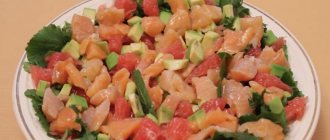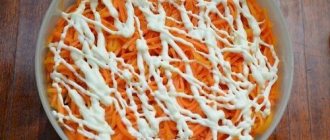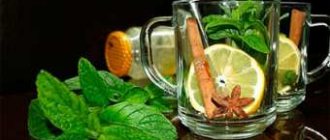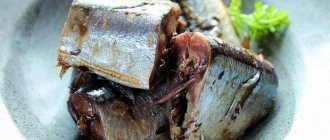We present to your attention the best recipes for preparing chard for the winter to expand the family menu in the winter.
Swiss chard is rich in vitamins A and E, so it is useful for diseases of the blood, bones and diabetes. In addition, the original taste of juicy greens encourages many to find the best recipes for preparing chard for the winter. Having a freezer will allow you to freeze a sufficient number of leaves and petioles. Some people prefer to can, ferment or pickle the stems of the crop. Still, the unique taste of the herbaceous plant largely depends on the technology of preparing the dish. On this topic:
Tasty and healthy - preparing viburnum jam for the winter
Aug 23, 2020
How to make apple cider at home -...
Aug 19, 2020
We reveal the secrets of how to properly ferment cabbage for the winter
Aug 19, 2020
A piece of sunshine in a jar - pumpkin juice, recipe in...
Aug 6, 2020
BACK FORWARD 1 of 129
Chard salad
Kitchen appliances and utensils: sharp knife, cutting board, tablespoon and teaspoon, serving dish.
Ingredients
| Chard | 3-4 sheets |
| Lettuce | 3-4 sheets |
| Basil leaves | 2-3 leaves |
| Cherry tomatoes | 4-5 pcs. |
| Raspberries | 50 g |
| Strawberry | 50-70 g |
| Blueberry | 30 g |
| Blue cheese | 50-70 g |
| Olive oil | 1 tbsp. l. |
| Balsamic sauce | 1 tsp. |
Step-by-step preparation
- A salad with chard and fresh vegetables and fruits is quite interesting and unusual in taste. It is prepared very quickly and simply. Under running water, wash 3-4 leaves of chard, lettuce and 2-3 leaves of basil. We put them immediately on a beautiful dish on which we will serve the salad.
- Cherry tomatoes in the amount of 4-5 pcs. wash and cut in half. Randomly place the tomatoes on top of the greens. Also for the salad you will need about 50 g of fresh raspberries, 50-70 g of strawberries, which we cut into small slices, and 30 g of blueberries. Place all the berries beautifully on top of the greens. For the salad, you can use any other fresh berries that you like best.
- In the process of preparing an unusual salad, 50-70 g of blue cheese are used, but if you don’t have that, you can use any other one to taste. Cut the cheese into small cubes and also place randomly on a plate with salad.
- Top the salad with 1 tbsp. l. olive oil and 1 tsp. balsamic sauce. Salad with chard, cheese and fresh berries is ready. The dish turns out to be quite interesting and unusual in taste.
Health benefits of Swiss chard
Recent research has shown that chard leaves contain at least 13 different polyphenolic antioxidants, including kaempferol, a cardioprotective flavonoid also found in broccoli, cabbage, and strawberries. But along with kaempferol, one of the main flavonoids found in chard leaves is syringic acid. Syringic acid has received particular attention in recent research due to its blood sugar regulating properties.
Like beets, chard is a unique source of phytonutrients called betalains, which have the ability to detoxify the body.
Ingredients of chard (100g, boiled without salt):
- Vitamin A – 306 mcg – 38% daily value;
- Vitamin K – 327 mcg – 300% daily value;
- Vitamin C – 18 mg – 22% daily value;
- And also: thiamine, riboflavin, niacin, folic acid, vitamins B5 and B6, choline.
- Magnesium, iron, calcium, manganese, phosphorus, sodium, zinc, potassium, copper, selenium.
Benefits of chard:
- Chard is recommended for diabetes, obesity, anemia, after serious illnesses and also for spring vitamin deficiency.
- Just 1 serving of chard (200 grams) can provide 60% of the daily minimum of magnesium, the most important mineral in the body.
- Research has shown that chard helps regenerate pancreatic cells.
- It has hepatoprotective properties and removes toxins from the body.
- Strengthens the immune system.
- Chard contains a record amount of vitamin K, which, like calcium and magnesium, is necessary for the formation of bone tissue.
- Improves the functioning of the cardiovascular system.
Contraindications and harm
- Vitamin K
Since chard contains vitamin K, much more than the daily requirement required by the human body for normal functioning, it is important to observe moderation in consumption. After all, even the most beneficial vitamins can be harmful if the dosage is not followed.
An excess of vitamin K increases platelets and blood viscosity, and as a result, it is extremely undesirable to consume foods rich in vitamin K for patients with varicose veins, thrombophlebitis, some types of migraines, and people with high cholesterol levels.
- Oxalates
Due to the content of oxalic acid, it is recommended to boil chard, as well as spinach, for a short time before eating and drain the water to get rid of it.
The fact is that oxalic acid tends to crystallize, and therefore products that contain this acid are contraindicated for those who have problems with the kidneys and gall bladder.
If you are absolutely healthy, then adding a few leaves of fresh chard to your salad will not do any harm.
How to select and store chard
Choosing chard is not difficult - the leaves should be bright in color, shiny, juicy and crisp.
Always pay attention that there are no yellow or brown spots. Experienced chefs recommend choosing smaller leaves, they are more tender and tastier.
Chard should be washed under cold running water. Soaking leaves is contraindicated because in this way many beneficial substances are lost.
To keep chard leaves fresh longer, place them in a plastic bag and close tightly so that no air remains inside. Thus, chard can be stored in the refrigerator for up to 5 days. Leaves should be washed only immediately before use.
If you need to store a large number of leaves, they must first be washed, cut, placed in bags and frozen, as is done with spinach.
How to cook chard
The best way to get more benefits and nutrients is through quick cooking. First, lower the petioles into boiling water, cook for 2 minutes, then add the leaves and cook together for another 3. The vada needs to be drained, and the chard can then be used for its intended purpose. You can, for example, add it to an omelette, or pasta, or mix it with pieces of cheese and olives, garlic and olive oil, you get a wonderful vitamin salad.
Here are some ideas:
- In Italy, boiled chard is used to make vegetarian lasagna.
- Stuffed cabbage rolls in chard leaves
- Chard puff pastries
Chard, a product that certainly deserves more attention, because it is not a previously capricious plant that is so rich in vitamins and nutrients. An ideal option when you want to diversify your family's diet.
Cold appetizer
Cooking time: 25 minutes. Number of servings: 2-3 people. Kitchen appliances and utensils: cutting board, sharp knife, teaspoon and tablespoon, serving plate. Calorie content: 73 kcal per 100 grams of finished dish.
Ingredients
| Chard | 10 leaves |
| Bulgarian red pepper | 1/2 pcs. |
| Yellow bell pepper | 1/2 pcs. |
| Cream cheese | 100 g |
| Pine nuts | 50 g |
| Olive oil | 1-2 tbsp. l. |
Step-by-step preparation
- To prepare a cold appetizer, you will need about 10 chard leaves. The greens must be thoroughly washed and slightly dried.
- We prepare other ingredients, namely half a yellow and a red sweet pepper. We clear them of seeds and cut them into strips 7-8 mm thick.
- Place 1 strip of each pepper on each chard leaf. We also use cream cheese as a filling, which will require about 100 g in total.
- We wrap the chard leaf so that the filling protrudes slightly. Decorate everything on top with a few pine nuts. The latter will require approximately 50 g. Wrap the remaining chard leaves in the same way.
- A quick appetizer of chard leaves is ready. Place on a beautiful dish and pour 1-2 tbsp of the appetizer on top. l. olive oil. The appetizer is quite unusual and is suitable for any table or just a light evening dinner.
Growing chard
To grow chard, with a developed beautiful rosette, it is better to use non-acidic soil. The appearance of bright leaves will perfectly decorate the garden. When working with compact species, plants should be planted at a distance of approximately 25 centimeters. When working with petiole species with large leaves, the planting distance should be about 50 centimeters.
Gardeners who prefer growing chard for decorative purposes grow varieties of the plant, the following varieties of leaf beets:
- green-petiolate (distinguished by the presence of green leaves, the rosette is semi-erect or semi-spread);
- silver-petiolate (distinguished by the presence of silver-white petioles, as well as wavy leaves of a dark green or yellow-green hue, the rosette is straight or semi-erect);
- red-petiolate (distinguished by the presence of red-crimson petioles, dark green leaves with red veins, semi-erect rosette);
- yellow-petiolate (distinguished by the presence of yellow, occasionally orange petioles, dark green leaves with golden veins, semi-erect rosette).
Kutaby with chard
Cooking time: 30-45 minutes. Number of servings: 3-4 people. Kitchen appliances and utensils: measuring cup, deep bowl, rolling pin, cutting board, kitchen knife, hob, heavy-bottomed frying pan, spatula, serving plate. Calorie content: 98 kcal per 100 grams of finished product.
Ingredients
| Water | 90 ml |
| Flour | 150 g |
| Salt | taste |
| Beet leaves | 3-4 pcs. |
| chard leaves | 3-4 pcs. |
| Coriander leaves | 3-4 pcs. |
| Fresh dill | 4-5 branches |
| Brynza | 100-120 g |
Step-by-step preparation
- The dish requires ordinary dough. Place 150 g of wheat flour into a deep bowl, to which we gradually add 90 ml of water at room temperature. Add salt to taste and mix everything thoroughly with your hands until a homogeneous, soft dough comes out that does not stick to your hands.
- Using a rolling pin, roll out the dough into round layers 1-2 mm thick. The size of the pancakes from the dough should be approximately the same as pasties.
- A variety of greens are used as filling, namely: 3-4 leaves of fresh beets, chard and coriander, and 4-5 sprigs of dill. Finely chop all the greens and place them in a deep bowl.
- In a bowl with greens, add about 100-120 g of salted cheese, which must be chopped into small pieces. Place the filling of greens and feta cheese on a rolled out layer of dough and wrap it like a cheburek, crimping the edges well and giving the kutabs a flat shape.
- Heat a dry frying pan with a thick bottom over medium heat and fry the kutaba on both sides until cooked. On average, it is enough to fry them on each side for 2-3 minutes until golden brown spots appear.
- We transfer the finished kutabs with herbs to a beautiful plate and serve. The dish turns out very tasty, especially if eaten hot.
Healthy recipes
As mentioned above, the herbal plant is mainly consumed by vegetarians and raw foodists. You can prepare many healthy dishes based on it.
Here are some healthy and delicious recipes. It’s not for nothing that I grew this plant in my dacha.
Salad with butter
- It is necessary to pour boiling water over the chard leaves. This is necessary in order to kill pathogenic bacteria and pathogenic microflora from the sheets.
- Next, the chard is chopped: cut into small strips.
- This unique dish is seasoned with a small amount of olive oil.
Some people prefer to eat a light salad with natural yogurt. You can add a small amount of lemon juice to taste.
Salad with carrots
- Chop the carrots into strips using a grater.
- Add lemon juice.
- Leave in the refrigerator for a day to soak the carrots.
- The next day, take chard leaves, finely chop them and mix with carrots.
- Next, chop the garlic clove.
- Mix all the ingredients and season the salad with a minimal amount of olive oil.
Cucumber salad
- Fresh cucumber must be grated or cut into strips.
- With the herbaceous part of the plant, you need to do the same manipulation as above. First, pour boiling water over it, then chop it.
- The ingredients are mixed.
- Add oil to the salad.
- You can add salt to the salad to taste, but it is still healthier for the body to replace the salt with natural lemon juice.
As mentioned above, when stewing, the benefits of this product do not disappear. Experts and nutritionists recommend adding the herbaceous part of the plant to stewed cabbage or vegetable stew.
- You can stew the cabbage in your usual way. Add chard 20 minutes before the dish is ready.
- The ingredients of the dish are thoroughly mixed and cooked for another 20 minutes.
Many vegetarians leave reviews that there is almost no chard in this dish, since the taste is similar to stewed cabbage.
Swiss chard cabbage rolls
Cooking time: 1-1.5 hours. Number of servings: 6 people. Kitchen appliances and utensils: cutting board, kitchen knife, deep bowl, oven, hob, frying pan, tablespoon, spatula, coarse grater, deep baking dish. Calorie content: 154 kcal per 100 grams of finished dish.
| Chopped meat | 600 g |
| Onion | 2-3 pcs. |
| Carrot | 1 PC. |
| Vegetable oil | 1-2 tbsp. l. |
| chard leaves | 8-9 pcs. |
| Salt | taste |
| Ground black pepper | taste |
| Water | 1-1.5 l |
Step-by-step preparation
- For a hot dish you will need 600 g of minced meat. You can use any minced meat you like - pork, beef, chicken. If desired, you can cook cabbage rolls with minced vegetables. It is recommended to add 1-2 small onions, cut into small cubes. Salt the minced meat, pepper to taste and mix well.
- Prepare 8-9 chard leaves by washing them well under running water. Place each chard leaf on a board and add about 1 tbsp. l. minced meat. We wrap the leaf in the same way as a cabbage roll. Place all the preparations for cabbage rolls in a deep baking dish.
- Grate 1 carrot on a coarse grater and finely chop one small onion into cubes. Pour 1-2 tbsp into the pan. l. vegetable oil and heat it well. Add onions and carrots and fry over medium heat until tender. Place the vegetables in the form with cabbage rolls and add about 1-1.5 liters of water. Control the amount of liquid yourself; the water should be at the level of the cabbage rolls, but not cover them to the top. Be sure to salt the water to taste.
- Preheat the oven to 250 degrees and set the chard cabbage rolls to cook for a quarter of an hour. After 15 minutes, the chard cabbage rolls are completely ready and can be removed from the oven. They turn out to be very aromatic, and their taste is significantly different from ordinary cabbage rolls with cabbage.
What is chard? How they eat. Application
Chard is a biennial herbaceous plant of the amaranth family, a close relative of the red beet we know from childhood, but only the petioles and leaves are used for food. Unlike beets, the root of chard does not develop, but remains very small; as a result, all the attention and nutrients accumulate in its leaves.
The plant is quite large, reaching 60-70 cm in height. Fresh leaves are bright green, while the color of the petioles is usually red, but can also be white or orange, depending on the variety.
- Red petiole chard;
- Yellow petiole;
- Green petiolate;
- Silver-petiolate.
Chard is also highly productive; in one season, the plant can produce approximately 1 kg of petioles and leaves; it grows quickly and does not require special care.
Swiss chard is especially valued because it can be grown in early spring, when vitamins are still very scarce.
The Italians call this plant "beta", which means "red" in Celtic. There, its juicy leaves are valued for their delicate taste, beauty and nutritional value and are happily eaten fresh as part of salads, and they prepare a wide variety of dishes, from pasta to pies.
They say that even Aristotle mentioned chard in his works, because in ancient times, people living in the territory of modern Greece and Italy used this plant as a medicinal plant.
Today, when it is possible to thoroughly study the products we consume, scientists were surprised to discover how rich this type of salad is in the vitamins and minerals necessary for humans. Chard is in second place after spinach in the ranking of the healthiest vegetables, and now you will understand why. The whole secret is in its composition.
Video
The video presents several recipes that will help you prepare a variety of chard dishes.
All of them are quite simple to prepare, and the whole process is described in detail. You will find the ingredients for each dish in the video in the required quantity. Do you know what chard is and have you tried cooking something with it? Share your tried and true recipes using chard leaves in the comments.
Reader reviews
Nobody has written anything yet. Be the first!
Chard benefits
The leaves are rich in microelements: Potassium, sodium, magnesium, calcium, iron
Contains a lot of vitamin K, as well as vitamins: A, B6, B12, C, D, E.
Dietary fiber, proteins, carbohydrates. There is also sugar.
A minimum of calories is one of the best foods for a healthy lifestyle and weight loss.
©Albert Shen
Watch the video: Recipe for making chard cutlets
People have known about the benefits of chard since ancient times. Today it is used both in medicine and in cooking.
